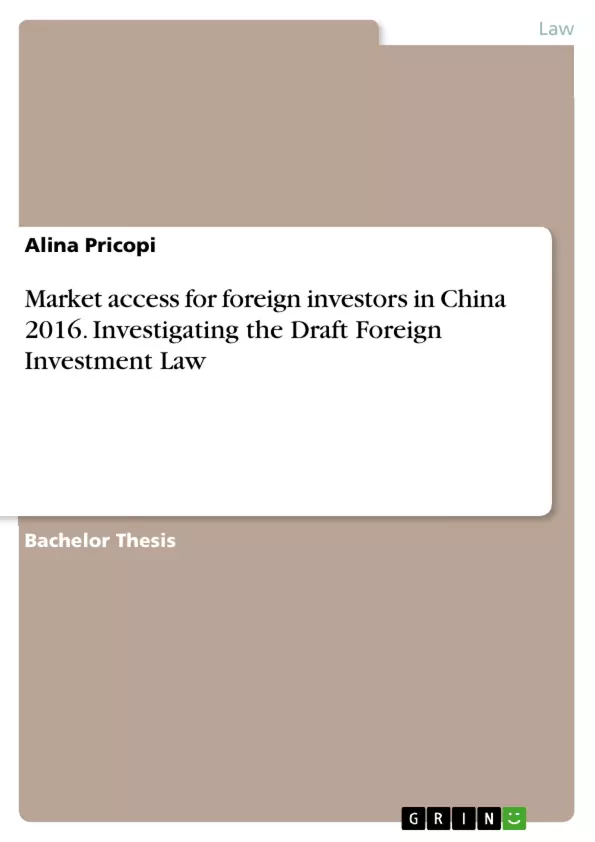The present bachelor thesis aims to analyse whether the proposed changes of the Draft Foreign Investment Law address the existing legal issues identified within the current market access structure of China.
Inhaltsverzeichnis (Table of Contents)
- Introduction
- Research question
- Methodology
- Structure
- The foreign investment framework of China
- Existing issues identified in relation to market access and transparency
- Pre-approval system
- Protection against expropriatory measures
- Variable interest entities
- Analysis of the Draft Foreign Investment Law of China
- Changes proposed by the draft foreign investment of china
- The pre-approval system
- Protection against expropriatory measures
- Variable interest entities
- Analysis on whether the changes address the existing legal issues
- The pre-approval system
- Protection against expropriatory measures
- Variable interest entities
- Conclusion
Zielsetzung und Themenschwerpunkte (Objectives and Key Themes)
This work analyzes the legal framework governing foreign direct investment (FDI) in China, focusing on the issues related to market access and transparency. Specifically, it examines the impact of the Draft Foreign Investment Law of China on the existing legal framework and whether the proposed changes address existing legal issues.
- The foreign investment framework in China
- Issues with market access and transparency
- Analysis of the Draft Foreign Investment Law
- The effectiveness of proposed changes
- The future of FDI in China
Zusammenfassung der Kapitel (Chapter Summaries)
The introduction provides an overview of the research question, methodology, and structure of the thesis. The second chapter analyzes the existing foreign investment framework in China, highlighting the issues related to market access and transparency. It then focuses on three specific issues: the pre-approval system, protection against expropriatory measures, and the use of variable interest entities.
The third chapter examines the changes proposed by the Draft Foreign Investment Law of China, specifically focusing on the same three areas: the pre-approval system, protection against expropriatory measures, and variable interest entities. This chapter delves into the specific alterations proposed by the draft legislation.
The fourth chapter assesses whether the proposed changes address the existing legal issues, analyzing each of the three areas individually. It assesses the effectiveness of the changes proposed by the Draft Foreign Investment Law in addressing the concerns related to market access and transparency.
Schlüsselwörter (Keywords)
The main keywords and focus topics of this text include: foreign direct investment (FDI), China, market access, transparency, pre-approval system, expropriation, variable interest entities, Draft Foreign Investment Law, legal framework.
- Citation du texte
- Alina Pricopi (Auteur), 2016, Market access for foreign investors in China 2016. Investigating the Draft Foreign Investment Law, Munich, GRIN Verlag, https://www.grin.com/document/314987



